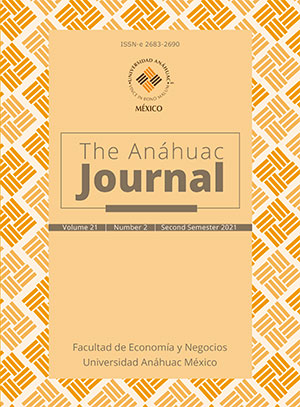Predictive model for the selection of a public opinion measurement technique
Main Article Content
Abstract
The objective of this article is to build a predictive model, based on information from projects carried out in market research and public opinion survey companies, choosing the recommended data collection method, which can be face to face interviews, telephone or online surveys, according to the requirements of each case. The predictive model type is one of classification, and several are built and analyzed using decision tree data mining techniques, discriminant analysis, K nearest neighbor analysis, and neural network analysis. Additionally, a segmentation of contacts in clusters is carried out to complement and enrich the knowledge provided by the classificati on techniques. It is concluded that the models generated by both decision trees and neural networks are the ones that best predict the public opinion measurement technique to be used.
Downloads
Article Details

This work is licensed under a Creative Commons Attribution-NonCommercial-ShareAlike 4.0 International License.
This work is licensed under a Creative Commons Atribución-NoComercial-CompartirIgual 4.0 Internacional.
References
Asociación Mexicana de Agencias de Inteligencia de Mercado y Opinión Pública, AMAI e Instituto Tecnológico Autónomo de México, ITAM. (2020). Estudio Anual de la Industria de Investigación de Mercados y Opinión Pública en México. Edición XXII (2019-2020). Reporte a Participantes.
Baker, R., Brick, J. M., Bates, N. A., Battaglia, M., Couper, M. P., Dever, J. A., Gile, K. J. y Tourangeau, R. (2013). «Summary report of the AAPOR task force on non-probability sampling». Journal of Survey Statistics and Methodology, 1 (2), 90-143. https://doi.org/10.1093/jssam/smt008
Berry, M. J. A. y Linoff, G. S. (2004). Data Mining Techniques. For Marketing, Sales, and Customer Relationship Management (2a ed.). Wiley.
Biemer, P. P. (2010). «Total survey error: Design, implementation, and evaluation». Public Opinion Quarterly, 74 (5), 817-848. https://doi.org/10.1093/poq/nfq058
Callegaro, M., Lozar Manfreda, K. y Vehovar, V. (2015). En Metzler, K. (ed.). Web Survey Methodology. SAGE Publications.
Chapman, P., Clinton, J., Kerber, R., Khabaza, T., Reinartz, T., Shearer, C. y Wirth, R. (2007). Metodología CRISP-DM para minería de datos. https://www.dataprix.com/es/book/export/html/107
Cornesse, C. y Bosnjak, M. (2018). «Is there an association between survey characteristics and representativeness? A meta-analysis». Survey Research Methods, 12 (1), 1-13. https://doi.org/10.18148/srm/2018.v12i1.7205
Couper, M. P. (2000). «Web Surveys: A Review of Issues and Approaches». Oxford University Press, 64 (4), 464-494.
Couper, M. P. (2017). «New Developments in Survey Data Collection». Annual Review of Sociology, 43 (1), 121-145. https://doi.org/10.1146/annurev-soc-060116-053613
De las Heras, M. (1999). Uso y abuso de las encuestas: elección 2000, los escenarios. Océano.
Escobar Terán, H., Alcivar, M. y Puris, A. (2016). «Aplicaciones de Minería de Datos en Marketing». Revista Publicando, 3 (8), 503–512.
European Society for Opinion and Market Research, ESOMAR. (2020). Global Market Research 2020.
Gera, M. y Goel, S. (2015). «Data Mining - Techniques, Methods and Algorithms: A Review on Tools and their Validity». International Journal of Computer Applications, 113 (18), 22-29. https://doi.org/10.5120/19926-2042
Gill, J. y Johnson, P. (2010). Research Methods for Managers (4a ed.). SAGE Publications.
Gorunescu, F. (2011). Data Mining. Concepts, Models and Techniques (vol. 12). Springer.
https://doi.org/10.1007/978-3-642-19721-5
Goul, M., Raghu, T. S. y Louis, R. D. S. (2018). «APC forum: Governing the wild west of predictive analytics and business intelligence». MIS Quarterly Executive, 17 (2), 157-183.
Grewenig, E., Lergetporer, P., Simon, L., Werner, K. y Woesmann, L. (2018). «Can Online Surveys Represent the Entire Population?». IZA - Institute of Labor Economics, 11799, 31.
Groves, R. M., Fowler, F. J., Couper, M. P., Lepkowski, J. M., Singer, E. y Tourangeau, R. (2009). Survey Methodology (2nd ed.). John Wiley & Sons.
Halper, F. (2017). Predictive Analytics. TDWI. https://tdwi.org/research/2017/06/advall-tdwi-navigator-report-predictive-analytics.aspx?tc=page0
Han, J., Pei, J. y Kamber, M. (2011). Data Mining: Concepts and Techniques. (3rd ed.)
Morgan Kaufmann. https://www.sciencedirect.com/book/9780123814791/datamining-concepts-and-techniques
IBM Corp. (2020). IBM SPSS Statistics for Macintosh (núm. 27). IBM Corp.
Jeffery, M. (2010). Data-Driven Marketing: The 15 Metrics Everyone in Marketing Should Know. John Wiley & Sons Inc.
Joseph, S. R., Hlomani, H. y Letsholo, K. (2016). «Data Mining Algorithms: An Overview». International Journal of Computers & Technology, 15 (6), 6806-6813. https://doi.org/10.24297/ijct.v15i6.1615
Larose, D. T. y Larose, C. D. (2015). Data Mining and Predictive Analytics. John Wiley & Sons Inc. https://www.wiley.com/en-us/Data+Mining+and+Predictive+Analytics%2C+2nd+Edition-p-9781118116197
Lavrakas, P. J. (1987). Telephone survey methods: Sampling, selection, and supervision. SAGE Publications.
Lee, H., Kim, S., Couper, M. P. y Woo, Y. (2019). «Experimental Comparison of PC Web, Smartphone Web, and Telephone Surveys in the New Technology Era». Social Science Computer Review, 37 (2), 234-247. https://doi.org/10.1177/0894439318756867
MacLennan, J., Tang, Z. y Crivat, B. (2009). Data Mining with Microsoft SQL Server 2008. Wiley Publishing, Inc.
Meyers, L. S., Gamst, G. C. y Guarino, A. J. (2013). Performing Data Analysis Using IBM SPSS. John Wiley & Sons, Inc.
Pforr, K. y Dannwolf, T. (2017). «What do we Lose with Online-Only Surveys? Estimating the Bias in Selected Political Variables Due to Online Mode Restriction». Statistics, Politics and Policy, 8 (1), 105-120. https://doi.org/10.1515/spp-2016-0004
Schober, M. F. (2018). «The future of face-to-face interviewing». Quality Assurance in Education, 26 (2), 290-302. https://doi.org/10.1108/QAE-06-2017-0033
Steeh, C. (2008). «Telephone surveys». En Leeuw, Edith D. de, Hox, Joop y Dillman, Don (eds.), International Handbook of Survey Methodology (pp. 221-238). Taylor & Francis Group.
Stupakevich, B., Sweenor, D. y Swiderek, S. (2019). Reporting, Predictive Analytics, and Everything in Between. O’Reilly Media.
Vehovar, V. y Lozar Manfreda, K. (2008). «Overview: online surveys». En Fielding, N. G, Lee, R. M. y Blank, G. (eds.). The SAGE Handbook of Online Research Methods (vol. 1, pp. 177-194). SAGE Publications.
Vehovar, V., Slavec, A. y Berzelak, N. (2012). «Costs and Errors in Fixed and Mobile Phone Surveys», en Gideon, L. (ed.), Handbook of Survey Methodology for the Social Sciences (pp. 277-295). Springer New York. https://doi.org/10.1007/978-1-4614-3876-2_16
White, A. y Rollings, M. (2021). 5 Key Actions for IT Leaders for Better Decisions. Gartner, Inc.
Zhang, X. C., Kuchinke, L., Woud, M. L., Velten, J. y Margraf, J. (2017). «Survey method matters: Online/offline questionnaires and face-to-face or telephone interviews differ». Computers in Human Behavior, 71, 172-180. https://doi.org/10.1016/j.
chb.2017.02.006

